Found a total of 10000 related content
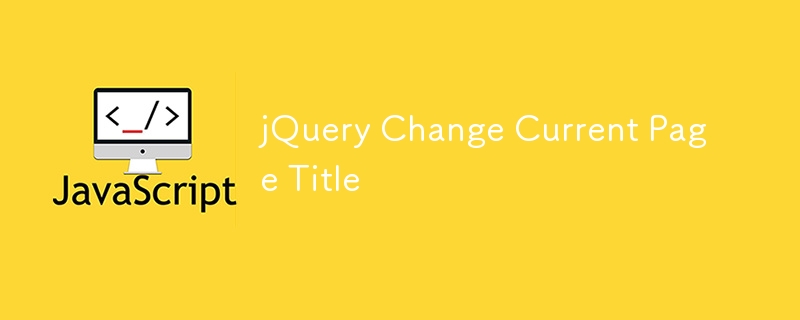
jQuery Change Current Page Title
Article Introduction:Although jQuery itself cannot directly modify web page titles, the same effect can be easily achieved using pure JavaScript. The following JavaScript code snippet can modify the full title of the current web page (i.e. the title displayed in the browser title bar):
document.title = 'New title';
FAQs about modifying page titles using jQuery (FAQs)
How to modify the title of a specific page using jQuery?
To modify the title of a specific page using jQuery, use the document.title property. This property allows you to get or set text in the title bar. Here is a simple example:
$(document).re
2025-03-04
comment 0
587
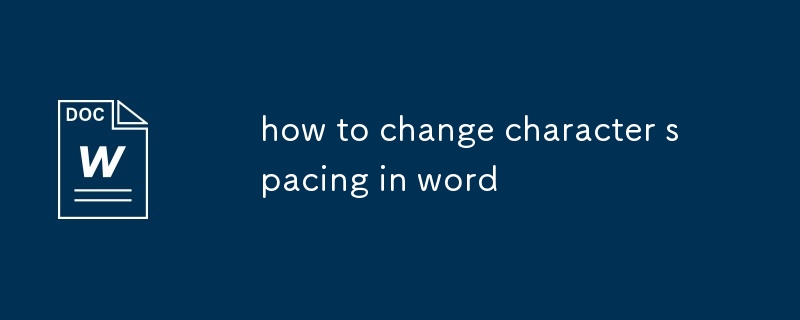
how to change character spacing in word
Article Introduction:Adjusting the character spacing in Word documents can be achieved in three ways. 1. Use font settings to adjust the character spacing: After selecting the text, select "Standard", "Wide" or "Closing" through the "Font" → "Advanced" tab, and set a value of 1-2 pounds, which is suitable for fine-tuning of the body; 2. Use "Text Effect" or "Text Box" for visual optimization: Put the text into the text box and select the visual style through "Text Effect" → "Convert", which is suitable for title design; 3. Avoid manually adding spaces to simulate spacing: due to confusion in typesetting, inconsistent display and difficulty in editing, it is recommended to always use built-in functions to ensure professional results.
2025-07-24
comment 0
975

how to turn a Word document into a PowerPoint presentation
Article Introduction:To convert a Word document to a PowerPoint presentation, first extract the key content and reorganize it. 1. First extract the main title from Word as the slide title, and simplify the content of the text into key points; 2. If you use Windows version of Word, you can try the "Send to PowerPoint" function to automatically create the slide; 3. If you cannot use this function, manually copy the title and content to PPT, and adjust the format and layout page by page; 4. Finally, optimize the visual effect, unify the style, streamline the text, add charts and adjust the layout to ensure that the overall concise and clearness are applied.
2025-07-06
comment 0
745

css animation examples
Article Introduction:Hover button zooms in to achieve interactive effects through transform:scale() and transition; 2. Fade in animation using @keyframesfadeIn with animation:forwards to maintain the final state; 3. Infinite rotation icon uses transform:rotate() and border differences to create loading effects; 4. Left and left jitter prompts to move between 25% and 75% keyframes through translateX to generate warning feedback; 5. Slide up and down banners from negative values to 0 to slide into vision; 6. Text typewriter effect simulates verbatim input through width gradient with steps() and adds cursor flash
2025-07-28
comment 0
305

how to motion track text in Premiere Pro
Article Introduction:The key steps to dynamically tracking text in PremierePro include preparing materials, adding text, and tracing motion. First, confirm that the tracking position is clearly visible, and locate the appropriate fragment on the timeline. Create a new project through the "File" menu and create a graphic template or use the old title tool to add text, adjust the font size, color and approximate position; then drag the text layer into the main timeline, open the "Effect Control" panel and use the "Motion Tracking Tool", set the tracking type to "Position", analyze the target area and bind the tracking results to the text layer; finally, for inaccurate tracking, you can manually fine-tune the keyframe or turn off automatic tracking correction, adjust the text transparency appropriately or add projections to enhance the sense of nature, if the tracking object is tilted
2025-07-16
comment 0
590

HTML for Single Page Applications (SPAs)
Article Introduction:The HTML structure of a single page application (SPA) needs to pay more attention to the initial loading experience, SEO support and maintainability. 1. The basic structure should be concise and complete, including doctype declaration, html tag, head area (meta tag, title, style sheet and script reference) and mount container div in body; 2. SEO supports dynamically setting title and meta description, and add OpenGraph or TwitterCard meta tags, appropriately add key text content or combine SSR/pre-rendering to improve search engine recognition effect; 3. The first screen optimization can speed up rendering through loading animation, skeleton screen, inline key CSS and using defer/async attributes, as well as
2025-07-29
comment 0
269

how to create a freeze frame title effect in Premiere Pro
Article Introduction:To create a FreezeFrameTitle effect in PremierePro, the key steps are as follows: 1. Intercept the frozen frame: Use the razor tool to cut out the target frame and copy it, or extract the frame as an image through the "Export Frame as Image" function; 2. Add title and animation: Insert text layer in the upper track, select the sans serif font, and set opacity, position or zoom animation to achieve a slow-in effect; 3. Enhance visual and auditory details: in conjunction with sound effects, adjust color contrast or add a viscera mask to enhance the sense of layering of the picture; 4. Optional multi-section freezing: Set multiple freezing frames continuously to enhance the rhythm. This process is simple but pays attention to detail and can effectively enhance the visual appeal.
2025-07-17
comment 0
968

Structuring Blog Posts with HTML `article` and `section`
Article Introduction:Using HTML and tags can effectively improve the clarity, accessibility and SEO effect of blog page structure. The specific usage is as follows: 1. Used for independent content blocks, such as blog text, user comments, news summary, etc., emphasizing self-containment; 2. Used to divide content blocks, usually with titles, indicating the theme of the part; 3. Both can be used in nested, such as for the main article, for internal logical parts, and then wrapped in related recommendations; 4. It is recommended to use the title level reasonably to avoid abuse, collocation and use, and keep the structure concise.
2025-07-18
comment 0
171

What is HTML and How It Works
Article Introduction:HTML is the basis of web page development. It is a markup language used to organize web page content such as text, pictures and links, and parse it through the browser and display it as a visual page. The browser reads tags in the HTML file, such as representing paragraphs, representing titles, displaying pictures, etc., and then renders them into a web page. The basic structure of HTML files includes,,, and tags. Common HTML tags include title tags to, paragraph tags, link tags, image tags, list tags, and container tags and. To start writing HTML, you only need a text editor and a browser. The specific steps are as follows: 1. Create a .html file; 2. Use the editor to write the basic HTML structure; 3. Add content to it; 4. Use the browser to open the file to view the effect.
2025-07-22
comment 0
944
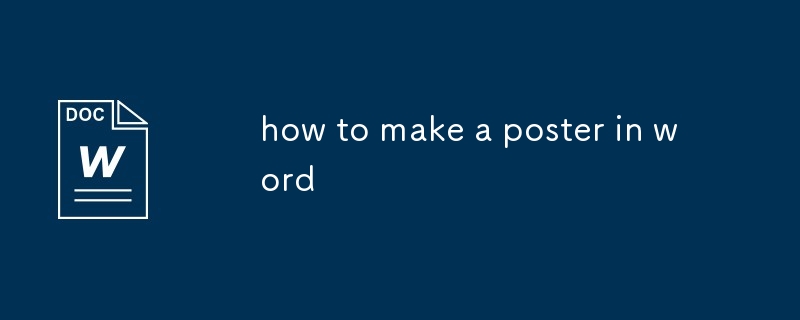
how to make a poster in word
Article Introduction:The key to using Word to make posters is to make rational use of typesetting and design functions. The first step should set the appropriate page size, click "Layout" → "Size" to select or customize the size, and adjust the proportion and margin according to the purpose; the second step should use the text box and shape reasonably, place the title, subtitle and text separately by inserting the text box, and use the shape tool to decorate to enhance the sense of layering; the third step should use pictures and icons to enhance the visual effect, pay attention to the clarity of the picture and beautify it appropriately, or use a solid background and white icon to keep it simple; the fourth step should adjust the font and color matching, control the font to 2 to 3 types, use bold and eye-catching fonts, and use easy-to-read fonts in the main color, and do not exceed three types of color tones to ensure that the background and text are contrasted significantly.掌握這些技巧���,結(jié)構(gòu)清晰����、重點(diǎn)
2025-07-30
comment 0
549
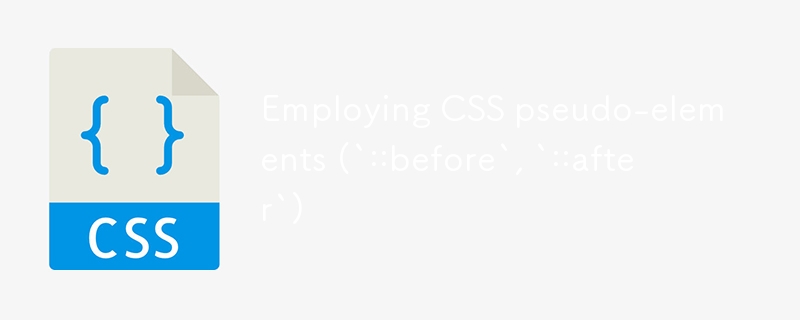
Employing CSS pseudo-elements (`::before`, `::after`)
Article Introduction:Use CSS pseudo-elements (::before and ::after) to insert content and enhance visual effects without modifying HTML. 1. The basic usage is to add text or symbols through the content attribute, such as inserting red prompt text before the paragraph; 2. Common techniques include inserting quotes, arrows, icon fonts and implementing small triangles and other UI details; 3. You can use to match positioning and styles to achieve decorative effects, such as small triangles in the prompt box, button hovering effect, etc.; 4. It was used to clear floats, such as .clearfix::after to solve the floating collapse problem; 5. Notes include: the content must exist, the pseudo-element defaults to inline, and cannot be operated by JS, and is not suitable for placing important content, because of its influence.
2025-07-06
comment 0
876
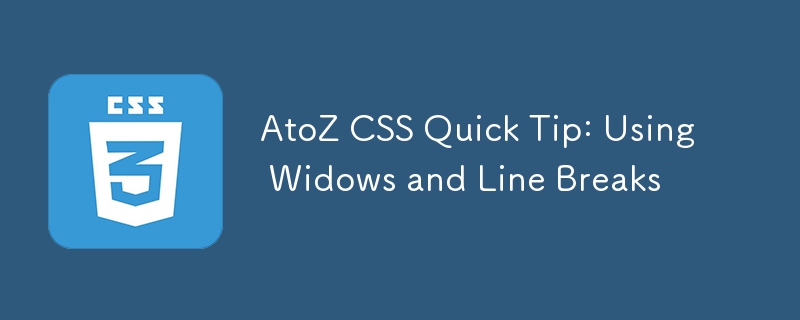
AtoZ CSS Quick Tip: Using Widows and Line Breaks
Article Introduction:Key Points
Avoid using the tag to force line wrapping, as this will cause text to appear inconsistently at different screen sizes. CSS is recommended to control spacing and line breaks, which provides better control and flexibility.
Use the display attribute to display or hide newlines. Setting display: none will not produce a line break, while display: block will produce a line break. In conjunction with media queries, line breaks can be enabled or disabled under specific screen sizes.
To avoid widow lines (single words at the end of a paragraph or title), use line-breaking space characters (?) between the last two words. This ensures that the last two words are processed as one word, creating a more beautiful line break effect.
2025-02-20
comment 0
1056
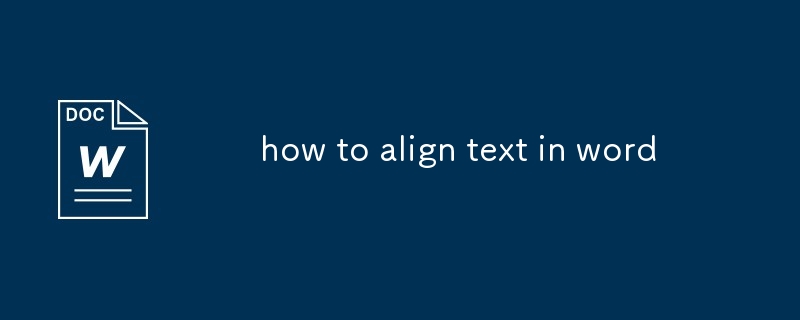
how to align text in word
Article Introduction:Use the correct alignment in Word to improve the overall aesthetics of the document. The left alignment is suitable for the text and is natural and easy to read; the center alignment is suitable for the title and highlights the visual effect; the right alignment is suitable for signatures and other contents on the right. The operation steps are: select text → click the alignment button under the "Start" tab. Align the two ends to automatically stretch the paragraphs, and the last line is aligned left, suitable for formal documents; dispersed alignment forces each line to flatten, suitable for promotional pages, but pay attention to the spacing of Chinese characters. If you need precise control, you can adjust the indentation, margin, first line indentation and other details through the "paragraph" settings, such as setting "first line indentation 2 characters" to improve format normativeness. Mastering these key points can effectively improve the quality of layout.
2025-07-21
comment 0
1031

What are lighthouse scores
Article Introduction:Lighthouse score is a tool developed by Google to evaluate web page quality, mainly covering performance, accessibility, SEO and other aspects. 1. Performance score measures loading speed and responsiveness, pay attention to indicators such as FCP, TTI, LCP, etc., and can improve by optimizing pictures, reducing JS, and using caches; 2. Accessibility score checks whether it is suitable for disabled users, and pays attention to contrast, alt text, semantic HTML and keyboard operations; 3. SEO scores examine search engine friendliness, including meta tags, title structure, robots.txt and sitemap.xml configuration; 4. Best practice scores involve HTTPS, API usage and CSS specifications; 5. PWA scores focus on installation
2025-06-29
comment 0
659

Understanding the purpose and usage of HTML attributes.
Article Introduction:HTML attributes are the way to add extra information to HTML tags, used to configure elements or adjust their behavior. Common attributes include class, id, src, alt, placeholder, etc. They are written in the start tag in the form of name="value", such as href specifying the link address, and alt provides alternative text for the image. Attributes are widely used, such as required to set the input box, triggering JS functions (onclick), and boolean attributes (disabled, checked) to take effect without a value. When using it, you should use quotes to wrap the attribute value, especially if it contains spaces or special characters; specific attributes are only applicable to the corresponding tag; custom
2025-07-02
comment 0
183

Implementing Custom HTML5 Input Pattern Validation
Article Introduction:The pattern attribute is a regular expression tool used for form verification in HTML5. It allows developers to restrict input formats through regularity. 1. It is valid only for text class input; 2. Regularity does not require anchor points, and case and escape need to be manually processed; 3. Common formats such as mobile phone numbers and passwords have corresponding expressions; 4. The browser compatibility is good but the prompt style is not uniform; 5. Prompt information can be provided with the title attribute; 6. Some mobile environments need to be tested or supplemented with JS verification. When using it, you should adjust the rules according to business needs and pay attention to their limitations. If necessary, combine JavaScript to implement more complex verification logic.
2025-07-08
comment 0
955
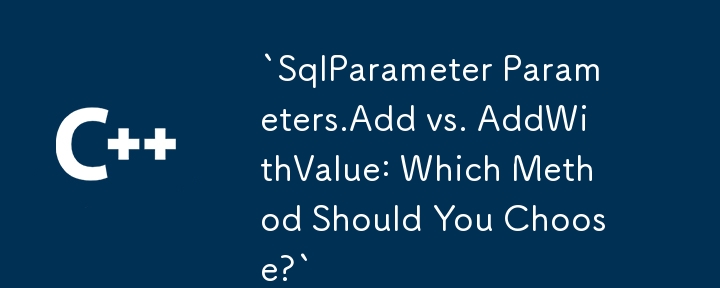

Dave The Diver: How To Catch Spider Crabs
Article Introduction:In Dave The Diver, there are some creatures that are not easy to catch. Or, catch alive that is. The spider crab is one of those very species, making it seem like the only way to bring these crustaceans back up to land is to viciously crack them up w
2025-01-10
comment 0
864
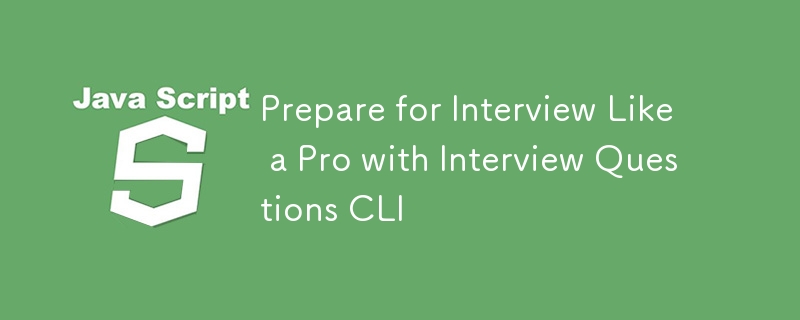
Prepare for Interview Like a Pro with Interview Questions CLI
Article Introduction:Prepare for Interview Like a Pro with Interview Questions CLI
What is the Interview Questions CLI?
The Interview Questions CLI is a command-line tool designed for JavaScript learners and developers who want to enhance their interview
2025-01-10
comment 0
1491



















